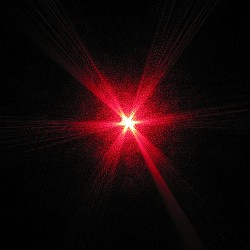 Engineers at University of California – Berkeley have grown nanoscale lasers directly on a silicon surface, an achievement that opens new possibilities in microprocessors, biosensors, and optical-electronic chips. Their findings are published in a paper the appeared 6 February in an advanced online issue of the journal Nature Photonics (paid subscription required).
Engineers at University of California – Berkeley have grown nanoscale lasers directly on a silicon surface, an achievement that opens new possibilities in microprocessors, biosensors, and optical-electronic chips. Their findings are published in a paper the appeared 6 February in an advanced online issue of the journal Nature Photonics (paid subscription required).
Greater demands on electronics for faster speeds and higher capacities have encouraged research into the properties of light and optics to carry more data than traditional electrical signals. Silicon, while being the foundation of modern microelectronics, is a poor generator of light, with the wrong atomic properties for most optoelectronics. As a result, electronics researchers have turned to different ways to create light-based components such as light-emitting diodes (LEDs) and lasers.
A promising class of materials is called III-V (“three-five”) semiconductors that can create LEDs and lasers, but it too suffers from the atomic mismatch between optoelectronics and silicon. The research by the Berkeley engineers, however, found a way of integrating III-V semiconductors with silicon.
A key barrier was the high temperatures — 700 degrees C — needed to develop III-V devices. The Berkeley team overcame this limitation by finding a way to grow nanoscale pillars made of indium gallium arsenide, a III-V material, on a silicon surface at the lower temperature of 400 degrees C (1 nanometer equals 1 billionth of a meter).
The researchers used metal-organic chemical vapor deposition to grow the nanopillars on the silicon. Once made, nanopillars generated light, at near infrared laser wavelengths, at room temperature. The hexagonal crystal structure of the nanopillars creates a new, efficient, light-trapping optical cavity. Light circulates up and down the structure in a helical fashion and amplifies with an optical feedback mechanism.
Engineering professor Connie Chang-Hasnain, who lead the research team says the process they used is similar to those used today in industry. “This technique is potentially mass manufacturable,” says Chang-Hasnain, adding, “Such a system is already used commercially to make thin film solar cells and light emitting diodes.”
Read more: University Opens Silicon Photonics Chip Design Service
Photo: Nayu Kim/Flickr
* * *

 RSS - Posts
RSS - Posts
[…] Read more: Nanolasers Grown on Silicon, Boost New Chip Prospects […]